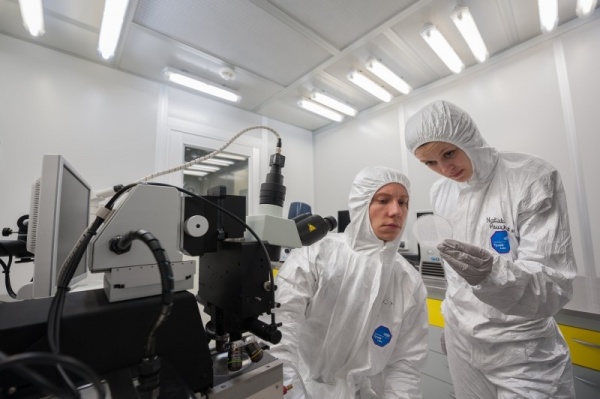A new device under development for a more effective fight against antibiotic-resistant bacteria
In this year alone, worldwide, about 700 thousand people will die as a result of the inefficacy of antibiotics. Many of them would survive if doctors were to rapidly obtain accurate information on the susceptibility of the bacteria attacking the patient to all the clinically important antibiotics. Institute of Physical Chemistry of the Polish Academy of Sciences in collaboration with a start-up BacterOMIC Ltd. aims to deliver the first laboratory instrument to provide all the information that the doctor will need to apply targeted therapies against multi-resistant pathogens.
We are constantly loosing antibiotics to resistance mechanisms spontaneously developed by the pathogens. New antibiotics will come to rescue, but not sooner than ten or so years from now. The first line of defense is in improved diagnostics. Due to the increasing drug-resistance of bacteria, the successful treatment of a particular patient is becoming more frequently dependent on microbiological analysis, which is the basis on which decisions are made in hospitals on the selection of the best treatment. Contemporary analytical instruments, however, provide very fragmentary information about bacterial antibiotic susceptibility
BacterOMIC AST, the analytical tool being developed in Warsaw, will for the first time allow doctors to obtain complete and accurate antibiotic resistance data for bacteria attacking a particular patient in a matter of just a few hours. The research and development work on the innovative device has just got under way with a 3.7 million PLN grant from the TEAM-TECH Foundation for Polish Science, awarded to the consortium created by the Institute of Physical Chemistry of the Polish Academy of Sciences (IPC PAS) and BacterOMIC Ltd., belonging to the Scope Fluidics S.A. group.
“According to grim estimates, over the next 35 years drug-resistant bacteria could lead to the death of up to 300 million people worldwide. We are no longer talking about an abstract threat, because if this bleak forecast comes true, in 2050 alone one in every thousand of the population will die due to drug resistance! So each of us will personally know someone who has died only because current antibiotics have stopped working,” says Prof. Piotr Garstecki (IPC PAS, BacterOMIC).
The sooner the patient gets the right antibiotic, the better. Contemporary analytical instruments do not, however, provide complete information on the antibiotic susceptibility of bacteria, nor do they investigate the efficacy of drug combinations. In general, these are devices that test only a limited portfolio of antibiotics and typically only in a simplified format, without establishing the real Minimum Inhibitory Concentration. The doctors often lack sufficient information about antibiotic susceptibility of the pathogen to make rational and effective therapeutic decisions.
BacterOMIC AST (Antibiotic Susceptibility Testing) is an analytical tool utilizing the microfluidics research that has been carried out at the IPC PAS for many years. The experience gained during research on controlling operations on droplets of micro- and nanolitre volumes and growing bacteria in them has made it possible, in collaboration with BacterOMIC Ltd., to design a device in which the bacteria-contaminated sample taken from the patient is separated into hundreds of micro-volumes after dilution. Each portion reaches one of the microcells on a small, removable disposable panel.
“On the plastic panel there are several hundred microcells containing different drugs at different concentrations. After adding the solution with the test sample, the bacterial culture is carried out in all microcells simultaneously. After up to a dozen or so hours our instrument assesses the development of the colonies and gives the physician not random but complete information on the antibiotic susceptibility of the bacteria attacking a particular patient,” explains Dr. Tomasz Kaminski, project manager at the IPC PAS.
The large capacity of a single panel in the BacterOMIC AST device makes it possible to test the efficacy of practically all clinically important antibioitics. Furthermore, the tests are performed for more concentrations than recommended by the main organizations dealing with bacterial drug resistance, such as EUCAST (European Committee on Antimicrobial Susceptibility Testing) or the US CLSI (Clinical & Laboratory Standards Institute). An antibiogram from the BacterOMIC AST device is thus not only complete, but it also contains very precise information on the efficacy of each antibiotic. Based on this, the physician can always reasonably construct the optimal therapy for a particular case of infection.
“In the microcells we also intend to experiment with selected mixtures of antibiotics. We will then be able to evaluate the mechanisms of bacterial resistance much better. No other currently available laboratory equipment can provide such information,” stresses Prof. Garstecki.
A single BacterOMIC AST device will make it possible to carry out analyses on 60 panels at the same time, with the cost of a single panel similar to existing devices. The instrument, now in its pre-prototype phase, has been tested for its potential for bacterial breeding and following bacterial growth in the microcells. Completion of the prototype construction is scheduled for autumn, after which tests in national and foreign laboratories will begin. The first BacterOMIC AST devices for hospitals and clinics should be available in approximately four years.
This press release was prepared with funds from the European ERA Chairs grant under the Horizon 2020 programme.
Author: dr inż. Tomasz Kamiński, prof. dr hab. Piotr Garstecki
Photo - Source: IPC PAS, Grzegorz Krzyzewski



